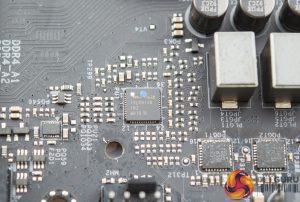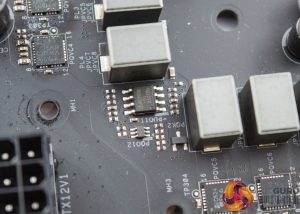ASRock's Z390 Phantom Gaming X continues a recent trend of ASRock to use predominantly black, grey and silver colours on its gaming motherboards, with red accenting that brings back memories of ASRock's now retired Fatal1ty branding that was somewhat over-zealous with painting things red. Overall, it's a clean and tidy design with the use of “thermal armour” hiding the component complexity and density that sits beneath.
Another design change in comparison to the Z390 Phantom Gaming 9 is the reduction of the extent of the onboard RGB lighting. The X model retains the lighting around the chipset heatsink and rear I/O cover, but the integrated lighting in the audio PCB section has been dropped. The Phantom Gaming X still retains the same pair of 12V RGB headers and a single 5V digital addressable. One difference is that the second 12v RGB header has been moved towards the middle of the motherboard.
ASRock equip 8 SATA ports on this motherboard which is somewhat prudent as there is a lot of bandwidth sharing between the chipset SATA ports and the M.2 slots when used in SATA mode.
If all three M.2 slots are used as SATA drives, only 1 chipset SATA port would remain available hence ASRock’s decision to equip two more SATA ports through an ASMedia controller. At this price point it is not unusual to expect buyers to have demanding storage requirements in both M.2 and SATA III varieties.
Along the bottom of the motherboard are two of the three RGB headers and some tweaking/diagnostic tools – dual BIOS chips, power and reset buttons and a code reader.
The CPU socket draws power from an 8 pin EPS connection with an optional 4 pin connector to add supplementary power, which for the majority of users will be unnecessary.
The CPU socket is supported by 14 power phases which are split up as 12 for the VCore and 2 for the iGPU, both making use of doublers back to the PWM controller.
There are two fan connections at the top of the CPU socket with a further two fan connections below it, it is therefore fairly simple for an AIO CPU cooler with two fans and a pump to be powered from this motherboard.
The “armor” sits on top and underneath, the top armor provides cooling for the chipset and M.2 slots while the bottom armor acts as a reinforced backplate for the motherboard.
A point to note is the two PCIe 1X slots on this motherboard are “closed-ended” unlike on the Phantom Gaming 9 where they are open-ended, this is largely due to the fact PCIe slot overhang is not possible as the thermal armor gets in the way.
The rear I/O is well equipped with ample networking, the red LAN port is the 2.5 Gigabit LAN connection, as well as ample USB including Type-C and 10Gbps ports. ASRock has added a pair of display ports capable of 4K UHD including DisplayPort 1.2 which can do 4K at 60Hz, though the HDMI port is only HDMI 1.4b so is limited to 30Hz at 4K. The small button is to clear the CMOS and makes for a complete diagnostic and tweaking package.
There are three M.2 slots all of which are cooled by the integrated thermal armor of this motherboard. This represents a notable upgrade over the Phantom Gaming 9 that had M.2 cooling for just one M.2 slot.
Access to the M.2 slots is a little clunky, requiring three screws to be removed using the provided screwdriver so that the whole armor cover is removed, to reveal access to all three slots.
We weren't able to remove and gain access to the audio components due to the plastic cover being held on with single-use push-pins. However, the configuration underneath, on paper specifications at least, does not appear to have changed compared to the Phantom Gaming 9.
ASRock is still using the latest Realtek ALC1220 codec and this is paired up with the Texas Instruments NE5532 headphone amplifier and Nichicon Fine Gold Series audio capacitors.
The PWM controller used is the Renesas Intersil ISL69138 which operates in a 6+1 channel mode, using doublers on all channels to give an effective phase count of 12+2. There are 12 doubled phases for the VCore and 2 for the iGPU/SOC.
All 14 phases use the Vishay SiC634 50A Integrated Power Stages, these are particularly heavy duty MOSFETs for this type of consumer application. The overall choice of components across the CPU VRM design is high quality and definitely over-engineered for most use cases.
Seven Renesas Intersil ISL6617A doublers are in use and visible underneath the motherboard. There is no thermal interface between these doublers and the backplate, but they are perfectly equipped to dissipate heat passively.
The CPU VRM heatsink is formed from two heatsink blocks that are connected by a nickel-plated copper heatpipe and using thermal pads. The design is a little denser and heavier than the heatsink used on the Z390 Phantom Gaming 9.
That backplate has no thermal solution within it so it serves primarily two purposes: structural rigidity and aesthetics.
The integrated I/O shield and cover can be removed and refitted with simple cross-head screws.
Some linear voltage regulators such as the Richtek RT7905 & RT9045, Diodes Incorporated AS393M-G1 and Anpec APW8720B make up the ancillary phases.
ASRock use the Hyper BCLK Engine II on this motherboard, and the corresponding chip is found towards the centre of the motherboard.
On the under-side of the motherboard the Realtek RTL8125AG chip which is used to provide the 2.5Gbps LAN solution.
Around the memory slots is a uP1674p PWM controller with a number of MOSFETs such as the SM4337 and ALK03CH, which provide the DDR4 power delivery system.
 KitGuru KitGuru.net – Tech News | Hardware News | Hardware Reviews | IOS | Mobile | Gaming | Graphics Cards
KitGuru KitGuru.net – Tech News | Hardware News | Hardware Reviews | IOS | Mobile | Gaming | Graphics Cards





























